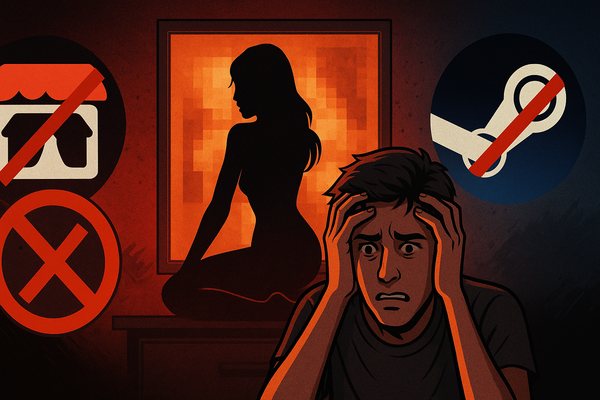How Long Game Marketing Really Takes: A Timeline Breakdown
Frustrated with slow game marketing results? Learn realistic timelines for influencers, social media, ads, and press so you can plan smarter and launch stronger. Start early, track KPIs, and hit your marketing goals with confidence. A must-read for game developers.
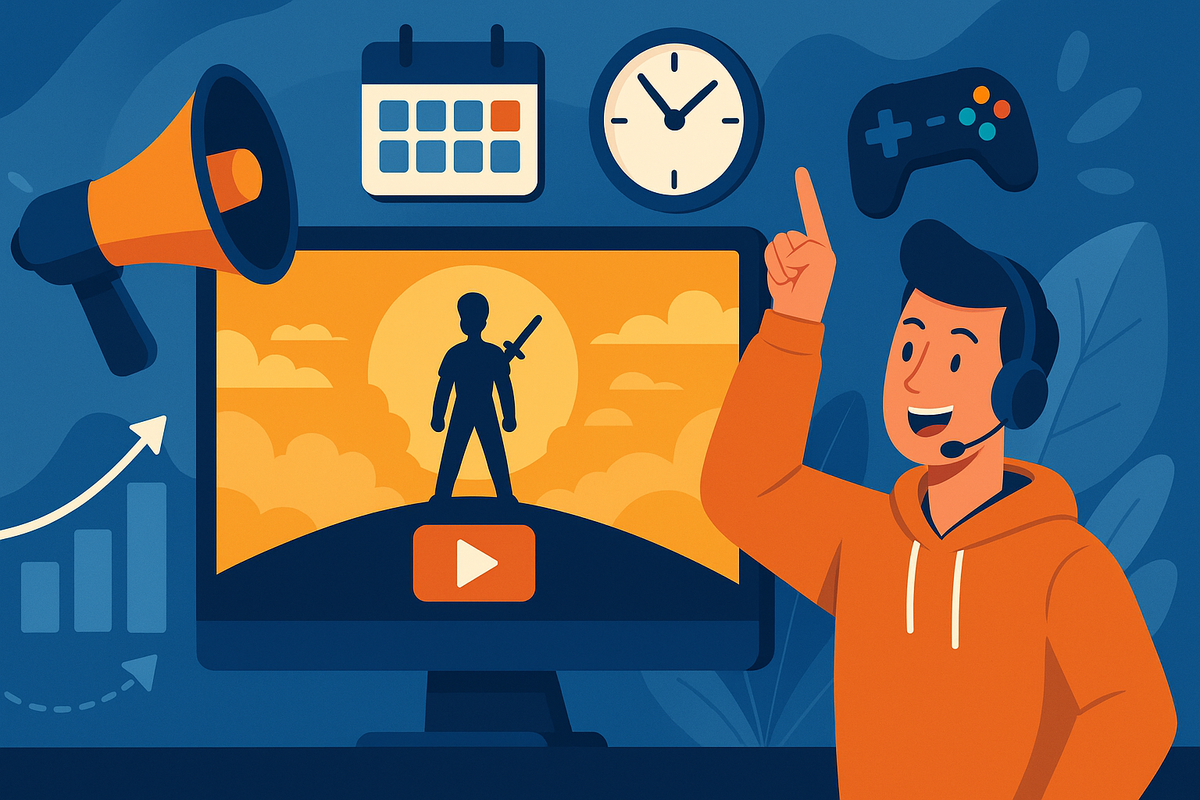
One of the biggest frustrations we hear from developers is that when they hire someone for marketing, "it takes so long for them to deliver any results." It's something along the lines of "I paid an agency/consultant and they haven't delivered any influencers or wishlists yet."
The other frustration we hear from developers who want to market themselves is that they've been executing a campaign themselves and not seeing any results. Many describe starting their social media presence as "it feels like I am screaming into the void."
In this article, we're discussing marketing timelines to help you:
- Structure your own timelines when marketing your games
- Evaluate timelines that marketers might give you
We will also show you can create a timeline for your game, completely free and accurate.
Understanding When to Start Marketing
The first crucial point to understand, and also one of the most overlooked areas, is when to begin your marketing. I want you to think of when to begin marketing like throwing a ball at someone running across a field.
If a person is running across a field, and you throw the ball where they currently are, you will miss them because they are no longer in that same spot. If you throw a ball to where the person is going to be, they can catch it because you're aligning their speed and trajectory with where the ball needs to be.

Marketing follows the same concept: you do not base marketing on where your development currently is and begin when the development is ready. Instead, you base it on where development is going to be (even if estimated) and then work backwards from there.
A great example: NextFest is happening on October 13, 2025, and you want influencers involved. October 13 is where you are throwing the ball. It takes about a month to get influencers onboard, which means you should start throwing the ball on September 13, 2025 to hit the target. With that understanding, let's dive into timelines for various marketing activities.
Influencer Marketing Timeline
You want influencers to market your game, and you're frustrated that an agency hasn't delivered any results yet. With influencers, there are two routes you can take:
Spray and Pray: This is the approach where you send out keys to influencers in hopes that they play your game. Results vary widely with this approach in terms of getting content created and created in a way that's best for your game.
Campaign Approach: This approach is when you work more closely with influencers to establish campaigns with set deliverables like short-form videos in addition to live streaming with specific usage rights.
So how much time does it take to get a single influencer? Let's break down how the process normally works:
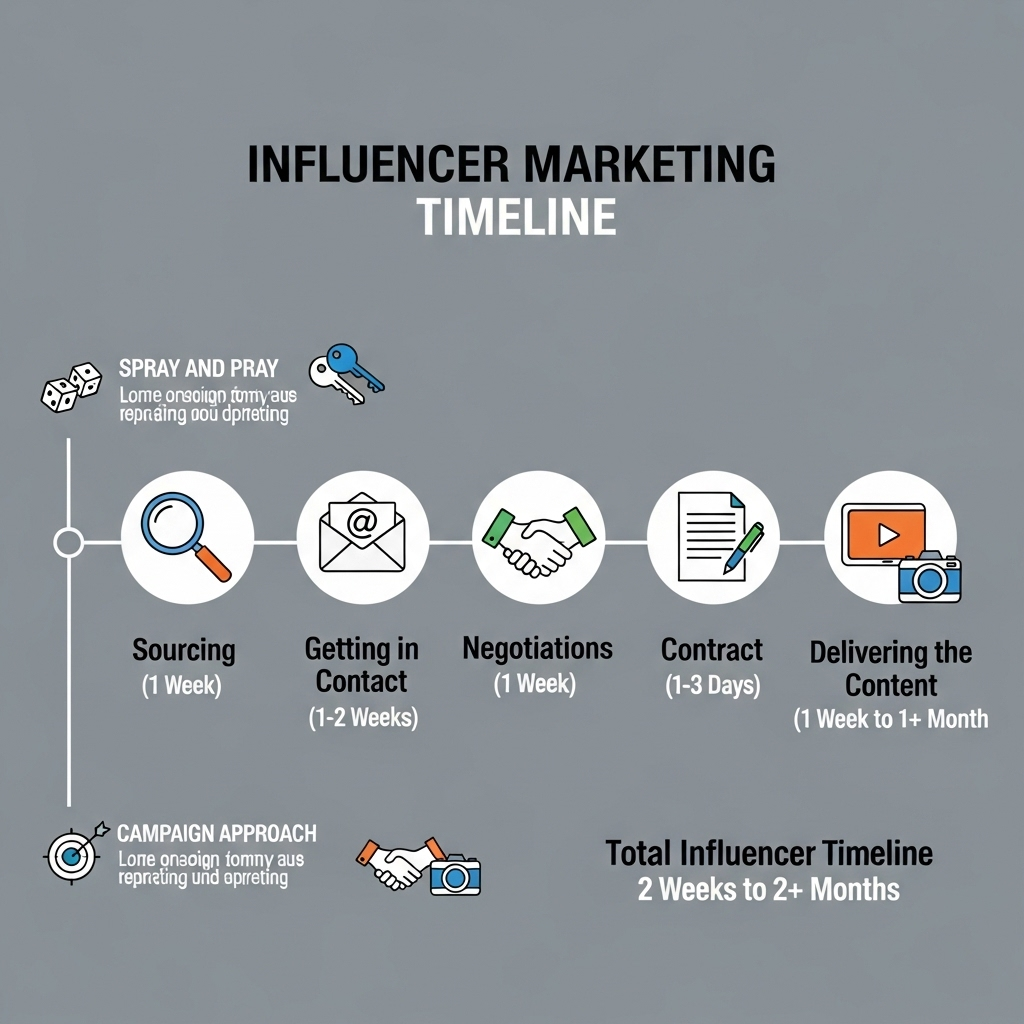
1. Sourcing (1 Week)
The first step is sourcing, or finding the right influencers for your game. You can target large influencers like Kai Cenat or Ninja who appeal to broad audiences, or you can be more specific and find influencers that are a perfect fit for your game. If you're doing the spray and pray approach, your list size should be between 200-300 influencers. If you're running a custom campaign, try to target about 100 influencers. This sourcing process takes about a week.
2. Getting in Contact (1-2 Weeks)
After you have your shortlist of influencers, then comes making contact. This really comes down to how often an influencer checks their email. Don't forget about follow-ups; we find that it's often the third message when an influencer actually responds and inquires more about your project. This can take another week or two.
3. Negotiations (1 Week)
Now, some influencers will take your game, play it, and create content just for fun or to entertain their followers. Others will want to discuss specific terms, especially if there's compensation involved and specific deliverable requirements. If there's an agent or manager representing the influencer, there will most definitely be back-and-forth negotiations about the deal. Add another week to get through this process.
4. Contract (1-3 Days)
After negotiations come the contracts. This should be mostly straightforward if the negotiations were clearly laid out. But of course, there can be redlining in the contract as well. Expect another 1-3 days for the contract to be finalized.
5. Delivering the Content (1 Week to 1+ Month)
Then the influencer has to deliver the actual content. If it's a livestream, many influencers have packed schedules and they have to fit your game into their existing commitments. This might be as short as a week or stretch over a month. If it's short-form or long-form content, expect about 2-3 weeks for them to create quality content for your game to post.
Total Influencer Timeline: When you take all of these factors into consideration, you're looking at anywhere from 2 weeks to two months to get content from an influencer. Larger influencers tend to take more time, while smaller influencers are faster—but you'll need more volume from smaller creators to deliver the same results as one major influencer.
Social Media Management and Growth
You hire an agency or consultant to handle social media marketing, or you plan to do it yourself. How many posts should be created and how soon should you expect to see results (follower growth, wishlist growth, etc.)?
Defining Your Audience and Brand (1+ Week)
If this is a brand new start on social media, then whoever is handling marketing needs to figure out what the brand represents on social platforms. What kind of content will they post? What's the posting cadence? What consistent messages does the brand want to convey? What about visual elements like colors and design consistency? How many posts per week? There's also the strategic mapping of how and where users are being directed. Easily allocate a week if not more just to get started properly.
Content Creation (10+ Hours per Week)
After the brand is figured out, or if the brand is already established, then it's time to produce content. A single piece of good content for social media takes about 1-2 hours to create properly. So if you're producing 5 pieces of content weekly, allocate about 10 hours for content creation alone.
Continual Content and Learning (1+ Month)
Now, a single piece or even 5 pieces of content isn't going to drive significant growth. Furthermore, some content will flop while others will perform exceptionally well. Over the course of a month, it becomes a learning experiment to discover what kind of content will drive growth for your specific game and audience. This has to be consistent throughout the month; if there are stop-and-start periods, that cadence is ruined and you lose your content's compounding effect.
Total Social Media Timeline: Overall, social media will take a little over a month until you can start to measure meaningful results. Make sure that you're actively tracking bottom-line Key Performance Indicators (KPIs) like wishlist growth, installs, organic reach, and follower growth religiously.
Advertising Timeline
Advertising can feel like the biggest black box, where it seems like the platform is the only winner. The biggest mistake we see is that not enough time or budget is allocated for conversions, and that conversion APIs are not properly implemented. To understand how to correctly set up ad campaigns, the process normally follows this path:
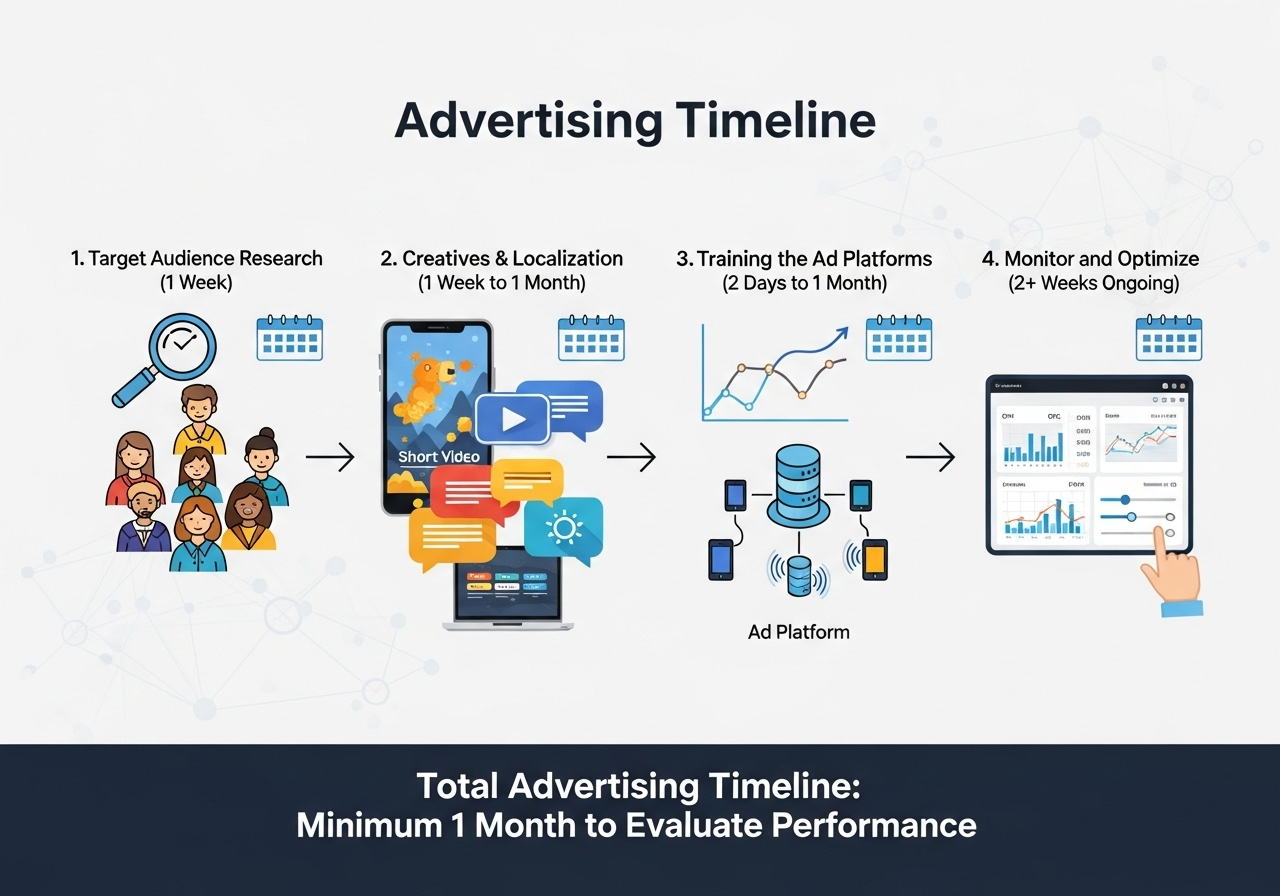
1. Target Audience Research (1 Week)
The first item that needs to be understood is who your target audience actually is. This involves researching your game's genre, gameplay mechanics, and other defining aspects. If you've been doing social media or have some data from Steam, this can make the research process faster. But it will take about a week to do this correctly and thoroughly.
2. Creatives & Localization (1 Week to 1 Month)
Next comes creating the advertising creatives. You want to have both images and videos, plus several versions of ad copy text. Even better is if you localize your ads for specific regions and cultures, adapting both visual and textual elements appropriately. This can be as quick as a week for basic quality creatives, or up to a month for more substantive, polished creative assets.
3. Training the Ad Platforms (2 Days to 1 Month)
Now comes the time for actually running the ads. Ad platforms improve their conversion performance by learning over a period of time. Without sending conversion data back to the ad platform (via tracking pixels), ad platforms can only marginally improve the quality of traffic they send you. If you really want to dive deep into training ad platforms effectively, research conversion APIs and their implementation.
With proper tracking pixels in place, a good training benchmark to start with is about 50 conversions. This can take anywhere from 2 days to 30 days, depending on numerous factors like your game's price point and how much you're spending to generate the right volume of conversions. More ad spend typically means faster platform training.
4. Monitor and Optimize (2+ Weeks Ongoing)
After a certain amount of time and ad spend, the metrics need to be analyzed and optimized. This includes examining metrics like Cost Per Mille (CPM), Cost Per Click (CPC), Click-Through Rates (CTR), and actual conversions. Review frequency depends on the volume of traffic being generated. Personally, I prefer to check and optimize around every 10,000 impressions, but each marketer will have their own preference. Just avoid going too granular, like 1,000 impressions, as the sample size might be too small to draw meaningful conclusions. Give this optimization process about 2 weeks minimum.
Total Advertising Timeline: When you tie it all together, advertising requires research (1 week), creatives and localization (1 week), initial training of the ad platform (1 week), and optimization (2+ weeks). You're looking at a minimum of 1 month before you can really start to evaluate performance accurately, and often longer for optimal results.
Press and Publications Timeline
You want to get your game featured in publications and gaming blogs. Let's walk through the press release process and lay out a realistic timeline for how it works:
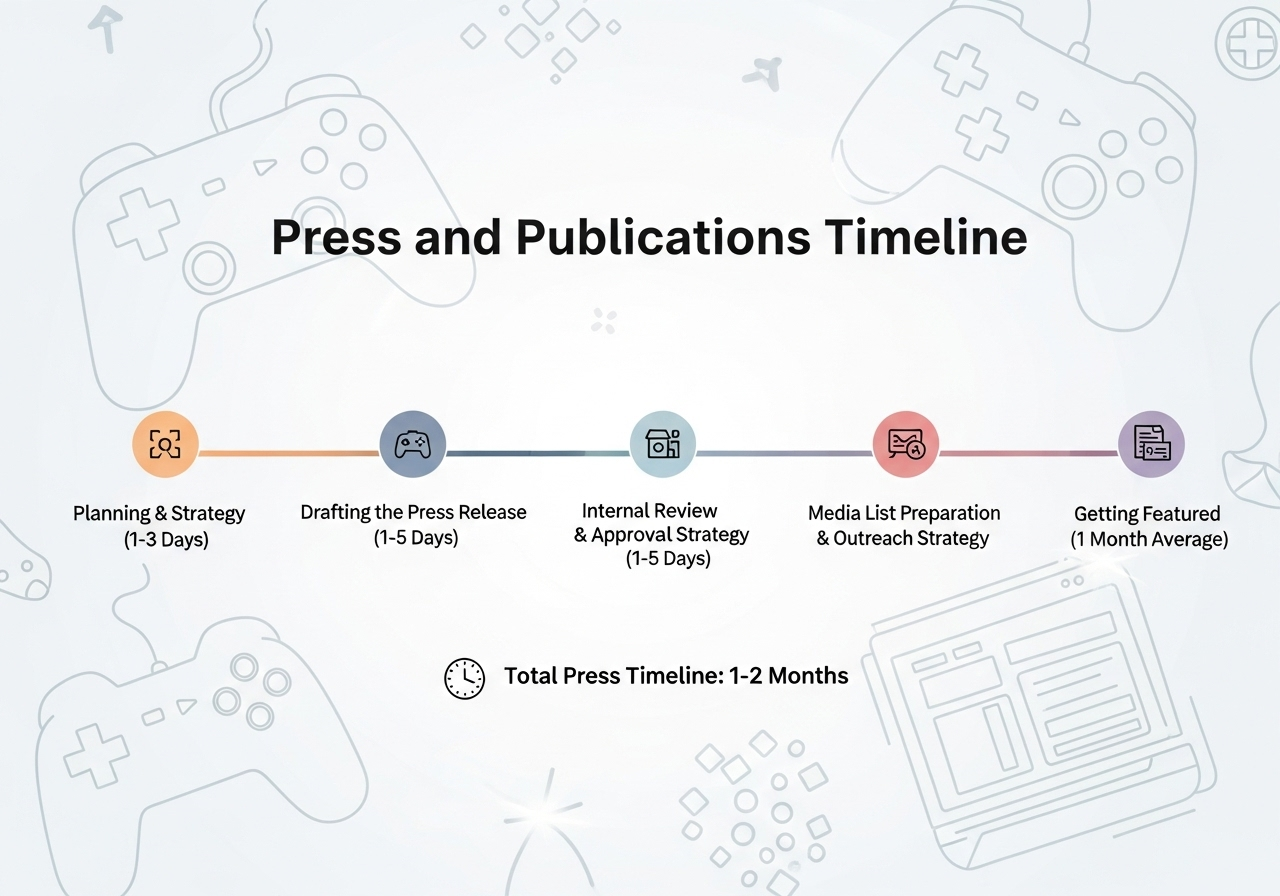
1. Planning & Strategy (1-3 Days)
The first step in any press release is defining the angle, audience, and goals of the PR effort. This involves:
- Identifying the news hook (launch, major update, milestone, partnership, etc.)
- Defining the target audience (gamers, investors, industry professionals, etc.)
- Choosing the appropriate tone and key messaging
- Aligning the press release with your broader marketing timeline and strategy
2. Drafting the Press Release (1-3 Days)
Next, the press release has to be written with precision and impact. This requires:
- Crafting a clear, compelling press release with an attention-grabbing headline, informative subhead, and concise body text (typically 300-600 words)
- Gathering all supporting media (high-quality images, trailer links, logos, screenshots)
- Including a meaningful quote from the developer or company founder
- Writing a professional boilerplate description about the company
- Including proper contact information and a clear call to action
3. Internal Review & Approvals (1-5 Days)
No one wants their game to be misrepresented in the press. This critical step requires:
- Comprehensive team review to ensure accuracy and proper messaging
- Legal clearance when necessary
- Stakeholder sign-off from decision-makers
- Often multiple revisions based on feedback from various team members
- Final approval from key decision-makers
While this process can take 1-3 days in well-organized teams, it depends heavily on how much decision-makers prioritize marketing. We've seen some companies where decision-makers consistently delay marketing approval, causing this process to stretch into weeks.
4. Media List Preparation & Outreach Strategy (1-3 Days)
Then comes preparing for strategic distribution:
- Curating a targeted list of relevant journalists and outlets (gaming press, tech publications, entertainment media)
- Personalizing pitches for high-priority contacts and key relationships
- Setting up distribution via wire services (like GamesPress or PR Newswire) for broader reach
- Timing the outreach for maximum impact
5. Getting Featured (1 Month Average)
This is the longest and most unpredictable part of the press release process: actually getting featured. Even if a publication loves what you're pitching and wants to feature your game, publications operate on their own editorial calendars and content schedules. Unless your game has something that makes it feel like breaking news (like a revolutionary new control method or groundbreaking technology), you'll likely need to wait for an appropriate publication slot.
Total Press Timeline: The entire press and publications process typically takes 1-2 months from initial planning to seeing your game featured in target publications.
Create A Free Timeline For Your Game
If you need a timeline for your game, that is one of the tools that Glitch offers game developers for free. Our marketing planning tool will take into account:
- Genre of your game and historical performance of that genre
- Time to launch of where you are post launch
- Budget you have to spend, if any
- Goals (wishlists, sales, retention, etc)
- Channels you want to use (influencers, social, ads, PR, etc)
And it has been trained from some of top datasets and strategies of games like Assassins, Balatro and hundreds of the others to give a marketing template and timeline for your game. Try it out here: https://www.glitch.fun/publishers/marketingplan
Working Backwards: Planning Your Marketing Timeline
When you're planning marketing for your game, you want to examine these timelines and work backwards to understand when you should start each marketing channel and when you'll likely see meaningful results.
Key Timeline Summary:
- Influencer Marketing: 2 weeks to 2 months
- Social Media Growth: 1+ month for measurable results
- Advertising Campaigns: 1+ month minimum for optimization
- Press & Publications: 1-2 months total
Remember: marketing is about throwing the ball where your development will be, not where it currently is. Start early, be patient with the process, and track your KPIs religiously to measure true success.


